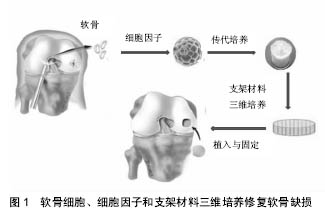| [1]Christensen BB, Foldager CB, Olesen ML, et al. Experimental articular cartilage repair in the Göttingen minipig: the influence of multiple defects per knee.J Exp Orthop. 2015;2(1):13. [2]de Windt TS, Vonk LA, Brittberg M, et al. Treatment and Prevention of (Early) Osteoarthritis Using Articular Cartilage Repair-Fact or Fiction? A Systematic Review.Cartilage. 2013;4(3 Suppl): 5S-12S.[3]Zhao M, Chen Z, Liu K, et al. Repair of articular cartilage defects in rabbits through tissue-engineered cartilage constructed with chitosan hydrogel and chondrocytes. J Zhejiang Univ Sci B. 2015;16(11): 914-923.[4]Peretti GM, Pozzi A, Ballis R, et al.Current surgical options for articular cartilage repair.Acta Neurochir Suppl. 2011;108:213-219. [5]Chiang H, Liao CJ, Wang YH, et al.Comparison of articular cartilage repair by autologous chondrocytes with and without in vitro cultivation. Tissue Eng Part C Methods. 2010;16(2):291-300.[6]杨方军,张晓峰,吴兴杰,等.自体软骨细胞移植修复关节软骨缺损[J].世界最新医学信息文摘, 2013,(34): 91-94.[7]程聪,任士友,江小成,等.自体软骨细胞移植和微骨折术修复膝关节软骨缺损的Meta分析[J].中国组织工程研究, 2015,19(24):3916-3923.[8]崔春爱,杨镇洙,陈华勇.自体骨膜移植修复关节软骨缺损的实验观察[J].延边大学医学学报,2002,25(1):8-11.[9]王与荣,张文明.骨膜诱导再生关节软骨的组织学观察[J].中国修复重建外科杂志,1991,5(2):69-72.[10]马树强,姬海鹏,王坤正,等.骨-骨膜复合组织与软骨下钻孔治疗关节软骨缺损的实验研究[J].陕西医学杂志, 2004, 33(5):390-392.[11]Guo X, Zheng Q, Yang S, et al. Repair of full-thickness articular cartilage defects by cultured mesenchymal stem cells transfected with the transforming growth factor beta1 gene.Biomed Mater. 2006;1(4):206-215.[12]Quintavalla J, Uziel-Fusi S, Yin J, et al.Fluorescently labeled mesenchymal stem cells (MSCs) maintain multilineage potential and can be detected following implantation into articular cartilage defects. Biomaterials. 2002;23(1):109-119.[13]Lin L, Zhou C, Wei X, et al. Articular cartilage repair using dedifferentiated articular chondrocytes and bone morphogenetic protein 4 in a rabbit model of articular cartilage defects.Arthritis Rheum. 2008;58(4):1067-1075.[14]Yun A, Lee SH, Kim J. A phase-field model for articular cartilage regeneration in degradable scaffolds. Bull Math Biol. 2013;75(12):2389-2409.[15]Scholten PM, Ng KW, Joh K, et al. A semi-degradable composite scaffold for articular cartilage defects. J Biomed Mater Res A. 2011;97(1):8-15.[16]Song HX, Li FB, Shen HL, et al. Repairing articular cartilage defects with tissue-engineering cartilage in rabbits. Chin J Traumatol. 2006;9(5):266-271.[17]黎婷,孙晋虎,赵亮,等.骨髓间充质干细胞定向诱导分化成骨细胞移植修复腭裂骨缺损[J].口腔医学研究, 2011, 27(2): 113-115.[18]陈克明,葛宝丰,刘兴炎,等.骨髓间充质干细胞复合纤维蛋白凝胶修复大面积关节软骨缺损[J].中国矫形外科杂志, 2004,12(6):444-446.[19]Duan W, Da H, Wang W, et al. [Experimental study of tissue engineered cartilage construction using oriented scaffold combined with bone marrow mesenchymal stem cells in vivo]. Zhongguo Xiu Fu Chong Jian Wai Ke Za Zhi. 2013;27(5):513-519.[20]Muhonen V, Salonius E, Haaparanta AM, et al. Articular cartilage repair with recombinant human type II collagen/polylactide scaffold in a preliminary porcine study.J Orthop Res. 2015. doi: 10.1002/jor.23099.[21]肖丹.Ⅰ型胶原海绵吸附自体骨髓基质细胞修复兔膝关节软骨缺损[D].中山医科大学,2001.[22]Ko EC, Fujihara Y, Ogasawara T, et al. BMP-2 embedded atelocollagen scaffold for tissue-engineered cartilage cultured in the medium containing insulin and triiodothyronine--a new protocol for three-dimensional in vitro culture of human chondrocytes. Tissue Eng Part C Methods. 2012;18(5):374-386.[23]Lin PB, Ning LJ, Lian QZ, et al. A study on repair of porcine articular cartilage defects with tissue-engineered cartilage constructed in vivo by composite scaffold materials. Ann Plast Surg. 2010; 65(4):430-436.[24]Ahmed TA, Giulivi A, Griffith M, et al. Fibrin glues in combination with mesenchymal stem cells to develop a tissue-engineered cartilage substitute. Tissue Eng Part A. 2011;17(3-4):323-335.[25]陆史俊,左保齐,刘洪臣.丝素蛋白生物支架材料在骨组织工程中的应用进展[J].中国修复重建外科杂志, 2014, 28(10):1307-1310.[26]范志海,陆福男,张锋,等.丝素蛋白/透明质酸复合多孔支架材料的表征及细胞相容性[J].中国组织工程研究, 2012,16(29):5428-5432.[27]熊思.丝素蛋白的降解性能及其三维打印生物活性支架在皮肤中的应用研究[D].浙江大学,2015.[28]徐敬,赵建宁,徐海栋,等.壳聚糖及其衍生物在软骨组织工程中的应用[J].中国组织工程研究, 2015,19(25): 4081-4085.[29]史德海.新型仿生软骨组织工程用壳聚糖/Ⅱ型胶原支架的构建及实验研究[D].中山大学,2005.[30]Zhao M, Chen Z, Liu K, et al. Repair of articular cartilage defects in rabbits through tissue-engineered cartilage constructed with chitosan hydrogel and chondrocytes. J Zhejiang Univ Sci B. 2015;16(11): 914-923.[31]Chen R, Curran SJ, Curran JM, et al. The use of poly(l-lactide) and RGD modified microspheres as cell carriers in a flow intermittency bioreactor for tissue engineering cartilage.Biomaterials. 2006;27(25): 4453-4460. [32]Schuurman W, Harimulyo EB, Gawlitta D, et al. Three-dimensional assembly of tissue-engineered cartilage constructs results in cartilaginous tissue formation without retainment of zonal characteristics. J Tissue Eng Regen Med. 2013. doi: 10.1002/term.1726. [Epub ahead of print][33]Asawa Y, Sakamoto T, Komura M, et al. Early stage foreign body reaction against biodegradable polymer scaffolds affects tissue regeneration during the autologous transplantation of tissue-engineered cartilage in the canine model. Cell Transplant. 2012; 21(7):1431-1442.[34]Wright LD, McKeon-Fischer KD, Cui Z, et al. PDLA/PLLA and PDLA/PCL nanofibers with a chitosan-based hydrogel in composite scaffolds for tissue engineered cartilage.J Tissue Eng Regen Med. 2014;8(12):946-954. [35]Shahin K, Doran PM. Strategies for enhancing the accumulation and retention of extracellular matrix in tissue-engineered cartilage cultured in bioreactors. PLoS One. 2011;6(8):e23119. [36]Grad S, Loparic M, Peter R, et al. Sliding motion modulates stiffness and friction coefficient at the surface of tissue engineered cartilage. Osteoarthritis Cartilage. 2012;20(4):288-295.[37]Tanaka Y, Yamaoka H, Nishizawa S, et al. The optimization of porous polymeric scaffolds for chondrocyte/atelocollagen based tissue-engineered cartilage. Biomaterials. 2010;31(16):4506-4516.[38]戴刚,石宗利,李起鸿,等.新型骨与软骨组织工程支架材料制备及其性能研究[J].第三军医大学学报, 2002,24(5): 502-505[39]Yang Z, Chen Z, Liu K, et al. [Experimental study on tissue engineered cartilage complex three-dimensional nano-scaffold with collagen type II and hyaluronic acid in vitro]. Zhongguo Xiu Fu Chong Jian Wai Ke Za Zhi. 2013;27(10):1240-1245.[40]Zuo Q, Cui W, Liu F, et al. Utilizing tissue-engineered cartilage or BMNC-PLGA composites to fill empty spaces during autologous osteochondral mosaicplasty in porcine knees.J Tissue Eng Regen Med. 2016; 10(11): 916-926.[41]Madry H, Orth P, Kaul G, et al. Acceleration of articular cartilage repair by combined gene transfer of human insulin-like growth factor I and fibroblast growth factor-2 in vivo.Arch Orthop Trauma Surg. 2010; 130(10): 1311-1322.[42]Jin XB, Sun YS, Zhang K, et al. Tissue engineered cartilage from hTGF beta2 transduced human adipose derived stem cells seeded in PLGA/alginate compound in vitro and in vivo. J Biomed Mater Res A. 2008;86(4): 1077-1087.[43]石宗义.转化生长因子β1促进关节软骨缺损修复的量效关系比较[J].山东医学高等专科学校学报,2006,28(4): 241-243.[44]黄建荣.转IGF-I基因软骨细胞移植治疗关节软骨缺损的实验研究[D].中山大学,2003.[45]Fujihara Y, Takato T, Hoshi K. Immunological response to tissue-engineered cartilage derived from auricular chondrocytes and a PLLA scaffold in transgenic mice. Biomaterials. 2010;31(6):1227-1234.[46]Dai NT, Fan GY, Liou NH, et al. Histochemical and functional improvement of adipose-derived stem cell-based tissue-engineered cartilage by hyperbaric oxygen/air treatment in a rabbit articular defect model. Ann Plast Surg. 2015;74 Suppl 2:S139-145.[47]Li DW, Zhou Q, Guo P, et al. [Proliferation of tissue-engineered cartilage cells under compressive stress]. Nan Fang Yi Ke Da Xue Xue Bao. 2010;30 (11):2530-2532.[48]Hoenig E, Winkler T, Mielke G, et al. High amplitude direct compressive strain enhances mechanical properties of scaffold-free tissue-engineered cartilage. Tissue Eng Part A. 2011;17(9-10):1401-1411. |
.jpg)

.jpg)